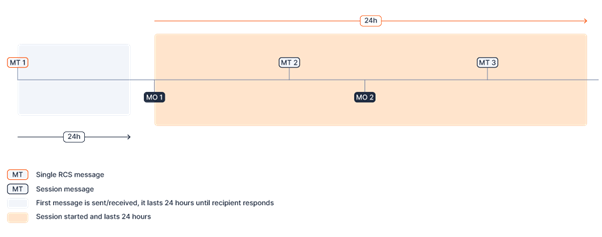Billing types
This section explains the different billing types for RCS messages, including global classifications and formats valid only in the United States. Each billing type is determined based on the message content, presence of media or suggested actions, and the direction and timing of the conversation between the business and the end user.
Global billing types
| Type | Description |
|---|---|
| Basic message | An application-to-person (A2P) message that:
Conversational agents only: |
| Single message | An application-to-person (A2P) message that:
Conversational agents only: |
| A2P conversation | Conversational agents only: Note If a P2A message is delivered within 24 hours of multiple A2P messages, only the A2P message that immediately preceded the P2A message is used to create the conversation session. |
| P2A conversation | Conversational agents only:
|
United States billing types
In the United States, there are two billing types:
- Rich messages
- Rich media messages
Message classification depends on whether the content is text-only with basic actions or contains media and advanced suggested actions.
Type | Description |
|---|---|
| Rich media message | An application-to-person (A2P) or person-to-application (P2A) message that:
A rich media message can include suggested replies and suggested actions, such as Dial phone and Open URL (Browser). If the message contains any multimedia content, it is automatically classified as a rich media message. Note P2A billing: If a P2A message contains a file, it is billed as a rich media MO message. |
| Rich message | An application-to-person (A2P) or person-to-application (P2A) message that:
A rich card that only contains a title and/or description is not considered a text-only rich message. Note Text-only P2A messages are charged in 160-byte segments. |
Some carriers charge for P2A messages. Text-only P2A messages are billed in segments, following the same segmentation rules applied to A2P messages.
The following message types are billed as P2A:
- Real MO messages: Sent when an end user manually sends a message directly to an agent.
- Quick reply MO messages: Sent when an end user selects a Reply suggestion button.
- Request location MO messages: Sent when an end user shares their location after selecting a Request location suggestion button.
If a P2A message contains a file, it is billed as a rich-media MO message.
Mobile terminated (A2P) session/conversation scenarios
A2P scenario 1
The brand sends a message (MT 1) to the end user, to which the end user responds with MO 1, triggering session billing. The session lasts 24 hours, starting from the end user's response (MO 1). The first message from the brand (MT 1) is also included in session billing.
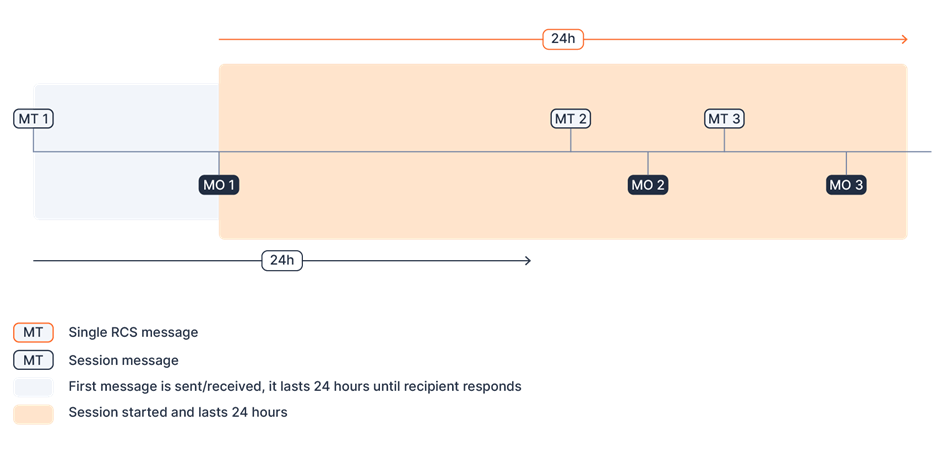
A2P scenario 2
The brand sent a message to which the end user never responded. The message is being billed as single/basic.
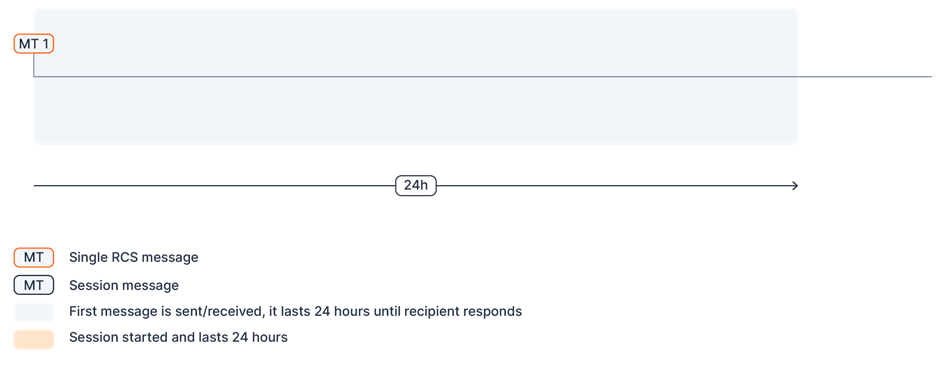
A2P scenario 3
The brand sent two messages within 24 hours. Each time a brand sends a message, the time period resets and starts again for the next 24 hours. That means that MT1 will be billed as a single message. The rest of the communication is within the scope of the session (which lasts 24 hours).

A2P scenario 4
The brand sent a message (MT 1) to which the end user (MO 1) responded after 24 hours. This MT1 message is being billed as single/basic. In this case, the end user's response (MO 1) has not triggered any session or any type of billing. This is only because MT 2 also occurred after 24 hours of the MO 1 message. So, after the second MT2 message from the brand, the session procedure is the same as in scenario 1.
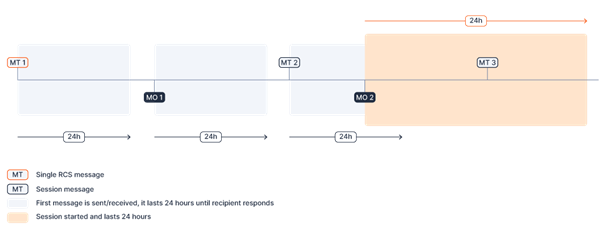
Mobile originated (P2A) session/conversation scenarios
P2A scenario 1
Here, we have an example of P2A communication, which means that the end user initiated the communication. In this situation, a 24-hour window session starts with an MOx message prior to A2P, and all A2P messages from that point are billed as a session (until the 24-hour window runs out).
Before MO1, there were no MTx messages or ongoing sessions in the previous 24 hours.
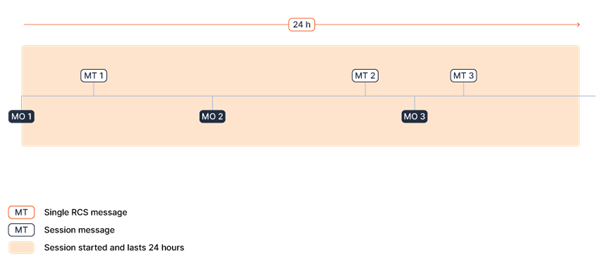
P2A scenario 2
In the case of multiple MO messages, only the last MO message (in this case, MO3) prior to MT1 will start the 24-hour window session, and the same logic applies as in P2A scenario 1.
- MO1 - 9:00 - 24-hour window begins
- MO2 - 10:00 - 24-our window begins
- MO3 - 11:00 - 24-hour window begins
- MT1 - 24:00 - first message
- MO4 - 9:00 next day
- MT2 - 10:59:59 - 24-hour session ends
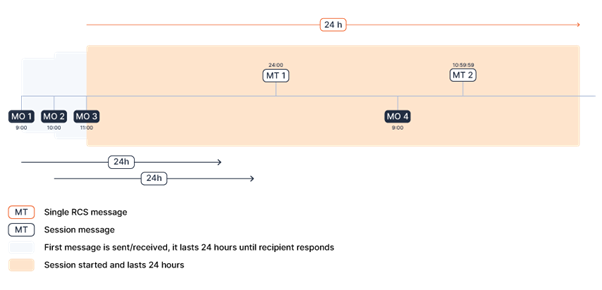
P2A scenario 3
This scenario covers situation where there was no response to Brand message (MT 1) in 24-hour period. Even though the end user responded (MO 1) after some point, this response was after first 24 hour session period, which means this is the beginning of P2A session now.
